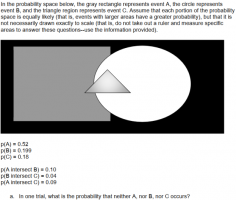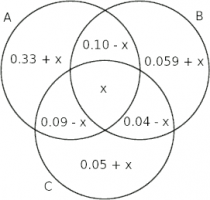lmprobability
New member
- Joined
- Jun 4, 2022
- Messages
- 5
Hello,
I believe I have over-complicated what should have been a simple conditional probability question.
I am provided with the probabilities of three events:
p(A) = 0.52
p(B) = 0.199
p(C) = 0.18
I am also given the intersect values:
p (A intersect B) = 0.10
p(B intersect C) = 0.04
p(A intersect C) = 0.09
The question asks: In one trial, what is the probability that neither A, nor B, nor C occurs?
Because I was not told that the events are independent, I will assume that they are not. Instead, I assumed they were dependent events and started to calculate using the formula P(a)P(B given A)P(C given A and B), but I started to doubt if this was the correct way to approach the problem. I believe there may be an easier way to solve this and I am just not interpreting the question correctly.
I understand that whatever answer I get for the probability of these three events occurring needs to be subtracted from 1 to determine the probability of neither occurring. At this point, I have spent almost 2 hours trying to solve this problem. I would be so appreciative if someone could please assist me in working through this problem step-by-step so that I may also improve my understanding of how you arrived at the answer. Thank you for your consideration!
I believe I have over-complicated what should have been a simple conditional probability question.
I am provided with the probabilities of three events:
p(A) = 0.52
p(B) = 0.199
p(C) = 0.18
I am also given the intersect values:
p (A intersect B) = 0.10
p(B intersect C) = 0.04
p(A intersect C) = 0.09
The question asks: In one trial, what is the probability that neither A, nor B, nor C occurs?
Because I was not told that the events are independent, I will assume that they are not. Instead, I assumed they were dependent events and started to calculate using the formula P(a)P(B given A)P(C given A and B), but I started to doubt if this was the correct way to approach the problem. I believe there may be an easier way to solve this and I am just not interpreting the question correctly.
I understand that whatever answer I get for the probability of these three events occurring needs to be subtracted from 1 to determine the probability of neither occurring. At this point, I have spent almost 2 hours trying to solve this problem. I would be so appreciative if someone could please assist me in working through this problem step-by-step so that I may also improve my understanding of how you arrived at the answer. Thank you for your consideration!


